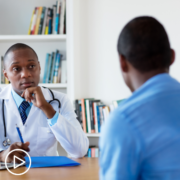How Do Race and Ethnicity Impact CAR T Side Effects?
How Do Race and Ethnicity Impact CAR T Side Effects? from Patient Empowerment Network on Vimeo.
How are CAR T side effects impacted by race and ethnicity? Expert Dr. Sikander Ailawadhi from Mayo Clinic shares some research study results about CAR T response rates and disease progression in African American and Hispanic patients and solutions for clinicians.
[ACT]IVATION TIP
“…there are some differences by race, ethnicity, specifically for the side-effect profile, patients should be aware of it, and clinicians who are the CAR T specialists should be aware of it so that they can manage the side effects well in their patients.”
See More from [ACT]IVATED CAR T
Related Resources:

|

How Can Information Disparities on Emerging Therapies Be Addressed? |

|
Transcript:
Lisa Hatfield:
Dr. Ailawadhi, real-world data from one of the available CAR-T-cell therapies, ide-cel (Abecma), has shown some differences in the side effect profile and benefit by patient race and ethnicity. What is your take on this, and how do you utilize this in your clinical practice? And also, what do you think researchers should do next to learn more about how CAR T therapies affect different people?
Dr. Sikander Ailawadhi:
This is an extremely important question, looking at what is the data currently on the risks and benefits of CAR T-cell therapy in patients from different racial ethnic groups, and then how are we using that in the clinic today and where should the field go about research in this area. So, Lisa, you’ve correctly pointed out that this study that was published recently is based on some real world data from one of the CAR T cells available, ide-cel.
Now, I shouldn’t say that this is specifically to ide-cel, but basically, ide-cel has been around a little bit longer than cilta-cel (Carvykti), and so the real-world data on ide-cel was to the point that this racial ethnic analysis could be done, and it was reported. That said, we don’t know how cilta-cel would be. That data just does not exist. So, I’m not saying that this is applicable to cilta-cel or not, because at least this study was specifically for ide-cel because that data was mature enough to be reported. That was just a qualifier of this particular question.
Now, what that study showed was that some of the side effects, including CRS, the cytokine release syndrome, and certain markers that can be an accompaniment of CRS, like the ferritin or what’s called CRP, C-reactive protein, which are inflammatory markers. So, inflammatory markers were higher in African Americans, and the CRS was also higher in African Americans from that real-world data.
The other thing that it showed was that the response rates were lower in Hispanics, but the progression-free survival, meaning time it took for the disease to progress and require more treatment, was lower in African Americans or overall survival was same across the racial ethnic groups. So, side effects a little bit more in African Americans, and the immediate response, a little bit less in Hispanics, but overall outcome, similar across races. Now, this is important for us to know because African Americans tend to have certain inflammatory disorders more frequently, like even asthma is seen more frequently in African Americans.
So, CRS, which is an immune system mediated inflammatory response, I can imagine that some of it might be higher in African Americans. So, in our clinics, what we are doing is when we are monitoring the patients, every patient is getting monitored the same way, but when it’s an African American patient, we are putting a little bit more focus on those inflammatory markers that can sometimes start showing up even before the CRS happens. I don’t think the response rate portion of Hispanics that we’re really taking into account much because the overall outcome or the long-term outcome was not really different between races and ethnicities.
Of course, there needs to be much more research, so I think we need longer-term follow-up data, we need larger number of patient data, and what I alluded to in the very beginning, we do need data on cilta-cel also, which has not yet been presented, but we are hoping that it will come out very soon. So, my activation tip for this question is, that there are some differences by race, ethnicity, specifically for the side-effect profile, patients should be aware of it, and clinicians who are the CAR T specialists should be aware of it so that they can manage the side effects well in their patients.
Share Your Feedback
Create your own user feedback survey



